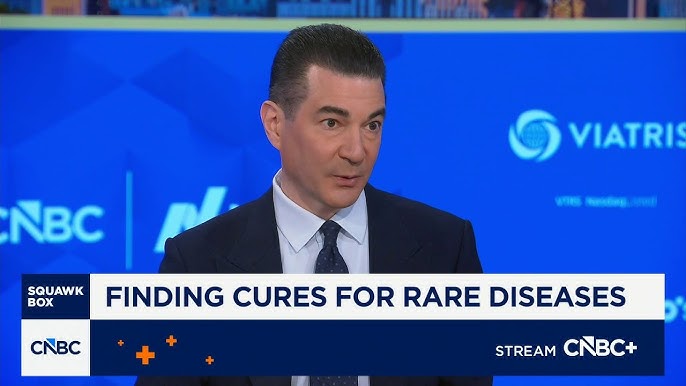
Dr. Scott Gottlieb on Finding Cures for Rare Diseases
Former FDA Commissioner Dr. Scott Gottlieb joins ‘Squawk Box’ to discuss the ongoing research and efforts at the FDA to find cures for rare diseases.…
Thought Leader: Scott Gottlieb
Last week we learned that, in June, prices throughout the U.S. economy continued to rise at a pace we simply have not observed since the “Great Inflation” period of 1966-1982. Tuesday’s report that consumer prices had risen 0.9 percent (11.4 percent at an annual rate) was followed Wednesday with news that producer prices had surged 1 percent (12.2 percent annualized), both roughly double what economists had been forecasting. Then, on Thursday, the Bureau of Labor Statistics reported that import prices also had continued to surge higher in June.
With the White House and congressional Democrats planning to follow their $1.9 trillion American Relief Plan with a $1.2 trillion infrastructure bill and a $3.5 trillion partisan spending bill, many are wondering whether inflationary pressure could worsen, and what that might mean for U.S. workers.
First, it is important to dispel the myth that substantially higher inflation is necessarily good for workers. The White House continues to celebrate strong wage gains in recent months but fails to account for inflation. In June, real average hourly and weekly earnings continued to decline, as big nominal gains were more than offset by surging prices. Year-to-date, adjusted for inflation, average hourly and weekly earnings are both down almost 4 percent at an annual rate.
While changes in the composition of the workforce are likely pulling down average wages, even if we address those compositional issues by looking at the Employment Cost Index or aggregate weekly earnings, the data indicate that employee compensation has generally not been keeping pace with inflation. In June, private employers’ total weekly wage bill actually declined by 3.5 percent at an annual rate in inflation-adjusted terms.
This should not come as a surprise, as wages similarly struggled to keep pace with inflation during the 1970s. By my calculations, during the recovery from 1975 to 1980, real wages actually declined at an average annual rate of 1 percent. During the same period, real household income growth for the bottom four quintiles lagged that of the top 20 percent, and their share of real income declined.
The reason is that while higher inflation can erode the value of existing household debts, borrowing costs quickly respond to reflect higher expected inflation. Moreover, not only do lower- and middle-income workers often have less bargaining power to negotiate higher wages, they also are disproportionately impacted by the rising cost of basic necessities — like food, gas and rent — as such expenses constitute a bigger share of disposable income at the lower end of the distribution. In the final years of the Great Inflation, rent inflation of close to 10 percent was outstripping nominal wage gains.
With supply-chain disruptions likely to persist for several more quarters, and with $4.7 trillion in additional fiscal stimulus potentially in the pipeline, are we likely to observe a rerun of 1970s-style inflation? At the moment, that probability seems low. While one-year inflation expectations have risen substantially, particularly among older and lower-income Americans, longer-term expectations have edged up much more modestly.
After rising inflation drove yields sharply higher in the first quarter, bond markets similarly seem to have tempered their long-run inflation expectations in response to recent signals that the Federal Reserve is attuned to the risks, even if that has not been reflected in current monetary policy.
Though a return to 1970s-style accelerating prices is a low (but non-zero) probability, a more probable scenario is that several shoes yet to drop will continue to push up the level of inflation expectations, if not the rate of change in those expectations.
Rent — which alone is 40 percent of the core Consumer Price Index — has still not returned to its pre-pandemic trend, and surging home prices over the past year eventually will be reflected in substantially higher costs for owner-equivalent rent. Pouring $4.7 trillion of additional stimulus and transfer payments into an economy that continues to face near-term challenges on the supply side will only exacerbate those price pressures, to the detriment of lower-income workers and renters.
The primary risk, therefore, is that the most profligate fiscal policy since the 1960s begins to test the limits of anchored inflation expectations, and thus forces the Federal Reserve to tighten sooner and more aggressively than markets currently anticipate, which would both substantially throttle growth and disrupt financial markets.
The unfortunate irony is that if inflation does surprise us to the upside, then President Biden indeed will be partially paying for his $4.7 trillion spending blowout — but he will be doing so via a “stealth tax” that most assuredly hits Americans earning less than $400,000.
Tyler Goodspeed is the Kleinheinz Fellow at the Hoover Institution at Stanford University, U.S. director at macroeconomics and geopolitical advisory firm Greenmantle LLC, and a senior fellow at the Adam Smith Institute. He served on the White House Council of Economic Advisers as a member and acting chairman from 2019 to 2021.
Dr. Scott Gottlieb on Finding Cures for Rare Diseases
Former FDA Commissioner Dr. Scott Gottlieb joins ‘Squawk Box’ to discuss the ongoing research and efforts at the FDA to find cures for rare diseases.…
Thought Leader: Scott Gottlieb
Peter Zeihan: U.S. Navy Seizes Russian Tanker
The US Navy just seized a shadow fleet tanker that managed to slip past the naval quarantine around Venezuela. The tanker reflagged as Russian while…
Thought Leader: Peter Zeihan
Erika Ayers Badan: Surviving Company Failure
In this episode of WORK: Unsolicited Advice, Erika talks through what it really looks like to come out of the worst month of your career…
Thought Leader: Erika Ayers Badan

